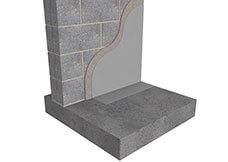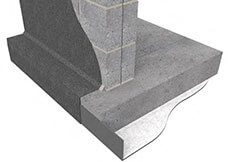01732 360 095
British Standard 8102:2022 defines three ‘Types’ of waterproofing and explains that the use of combined protection in various forms (e.g. Type A+B, Type A+C, Type B+C, Type A+B+C or Type A+A) should be determined where in a single system:
- a) the assessed risks are deemed to be high, or;
- the consequences of failure to achieve the required internal environment are deemed too high, which, it could be argued, is the case with most habitable basements.
It also states that where a combination is being considered, systems should have different performance characteristics to mitigate the risk of failure due to a common cause and that when combining types of protection, the compatibility of the different protection types should be assessed in order to minimise the risks and negate the need for remedial measures.
Therefore the desired ‘Grade’ of waterproofing protection to meet the client’s expectations should be explained to the design team by a waterproofing specialist before the RIBA technical design stage at the very latest.
As such, Newton provides standard or bespoke solutions for each of the three types of waterproofing, individually or combined, depending on project requirements.
How does basement waterproofing work?: Basement Waterproofing – An Overview
The British Standard: Requirements of BS 8102:2022
National House Building Council: NHBC Standards Chapter 5.4
Newton Waterproofing Index
The Newton Waterproofing Index (NWI) is a unique specification tool that provides a scoring system for waterproofing designs and assesses the likelihood that they will achieve the desired grade of waterproofing protection.
NWI scores vary depending on the type of waterproofing protection used and the structure they are applied to. Combining types of waterproofing will generally increase the effectiveness of the waterproofing design and, accordingly, the NWI score.
Each Newton Solution Sheet confirms the NWI score and indicates what grade of waterproofing protection can be achieved by using that specification.
Unique specification tool: Newton Waterproofing Index
Combined waterproofing: Structural Waterproofing – An Overview
Type A (Barrier) Protection
Type A waterproofing is defined by BS 8102:2022 as ‘barrier protection’ against water ingress. The protection is dependent on a separate barrier system being applied to the structure. This form of waterproofing is commonly referred to as ‘basement tanking’ and can be applied to the internal and external surfaces of the structure.
Type A – External Waterproofing
External Type A waterproofing systems are waterproofing barriers that are applied to the positive side of the structure. These should be continuous around the structure and provide continuity to DPC level. The barrier is pre-applied before the concrete slab is laid, or either pre- or post-applied to the walls, depending on the method of construction.
This form of waterproofing protects the structure against ground water ingress and aggressive chemicals within the water, such as sulphates. Some waterproofing barriers will also provide protection against radon and other ground gasses as part of a combined waterproofing and ground gas system.
Benefits
- Can provide an effective barrier that fully isolates the structure from ground water, aggressive chemicals and ground gasses.
External Type A Waterproofing Newton Waterproofing Index Score: 1.1 – 3.0

Related Products & Systems
Newton HydroBond System
Newton FlexProof 106
Newton HydroBond 410 GeoDrain
Type A – Internal Waterproofing
Internal Type A waterproofing systems are waterproofing barriers that are post-applied to the ‘negative’ surfaces of the already constructed structure. Where possible they should be continuous inside the structure and up to DPC level.

These products are typically liquid waterproofing membranes or slurries that can be applied either by spray, trowel, brush or roller.
Benefits
- Suitable for remedial and refurbishment projects.
- Can be the only option where external application is not feasible, such as with underpinning, or after substrate repair.
- Partial systems and localised application are also possible.
Internal Type A Waterproofing Newton Waterproofing Index Score: 2.0 – 3.0

Related Products & Systems
Newton HydroCoat System
Newton FlexProof 106
Diasen WATstop
Type B (Structurally Integral) Protection
Type B waterproofing is defined by BS 8102:2022 as protection against water ingress which is provided by the structure that is constructed of reinforced concrete or structural steel and designed in accordance with the relevant part of BS EN 1992 or BS EN 1993 respectively. These systems should also be continuous throughout all below ground areas terminating at 150mm above ground.
A combination of correctly specified joint sealing systems can be applied to places where there is no continuity of structure, such as joints and services penetrations, to prevent water passing through the structure.

Benefits
- Utilises the concrete structure as a form of waterproofing.
- Where the reinforced concrete structure has already been designed by an engineer to be waterproof to BS EN 1992, the additional waterproofing of construction joints, service entries and penetrations will result in a fully waterproof, Type B concrete structure.
Type B Waterproofing Newton Waterproofing Index Score: 1.3 – 1.9

Related Products & Systems
Newton HydroTank System
Hauff-Technik Service Entry Sealing Systems
RiveStop Tie Bolt Hole Sealing System
Type C (Drained) Protection
Type C waterproofing is defined by BS 8102:2022 as drained protection against water ingress into usable spaces, which is provided by the incorporation of an appropriate internal water management system.

Water that seeps through the structure, or any installed Type A or Type B waterproofing system, is depressurised, collected and the removed from the structure.
Benefits
- Suitable for new-build, refurbishment and remedial waterproofing.
- Considered by many to be the safest form of waterproofing.
- Commonly used as a second form of waterproofing due to the possibility of water entering through defects in Type A and/or Type B systems.
Type C Waterproofing Newton Waterproofing Index Score: 1.0 – 3.2

Related Products & Systems
Newton CDM System
Newton Pumping, Controls & Telemetry Systems
Newton Power Interruption Systems
Speak to our friendly, expert team
Our staff are able to provide guidance for projects of all sizes, whether you require some general advice about damp or waterproofing, or support with technical drawings and specifications.














